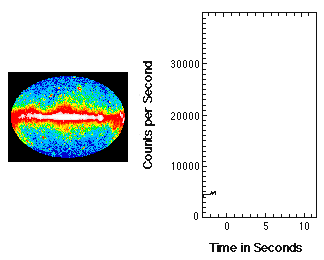
Gamma-Ray Bursts and their host galaxies
Gamma-Ray Bursts are spectacular bursts of gamma-rays that at a rate of
a few per day outshines all of the other sources of cosmic gamma-rays
on the sky added together.

It is still not known what produces these bursts, but it was early on
realised that GRBs distribute uniformly over the sky and hence can
not be related to objects in the Milky Way disk (where most of the stars
in our galaxy are found).
Since 1997 we have, mainly thanks to precise afterglow localisations by
the Italian/Dutch BeppoSax satelitte, learned that at least one class of
Gamma-Ray Bursts, the most common long-duration burts, originate from
extragalactic sources, most likely somehow related to the most extreme
supernova explosions in distant galaxies.
For this reason the occurrence of cosmic Gamma-Ray Bursts may be used to
probe the evolution of (massive) star formation in the universe. In more
detail,
by locating the galaxies that hosted the bursts we can build up a sample
of galaxies that is selected based on the occurrence of
star formation and which selection is independent on the emission
properties of the galaxies. This is crucial as it is currently unknown
how much star formation in the universe that is obscured due to dust
extinction in galaxies. The study of a sample of galaxies hosting cosmic
Gamma-Ray Bursts can most likely give us the answer to this question.
Until now our samples of GRB host galaxies still suffer from the bias
that it is much easier to locate the precise position of a GRB, and
hence its host galaxy, if it has a bright optical afterglow. This may
very well exclude very dusty host galaxies from the current samples
(although the burst it self may destroy some of the dust in its
environment). In the future precise X-ray and/or radio localisations
will hopefully lift this possible bias.
Another concern (or interesting issue dependent on your taste) is that
there could be other parameters in addition to mass controlling weather a
star ends up producing a gamma ray burst. One such parameter could be
metallicity. In the collapsar model by
MacFadyen and Woosley
low metallicity is predicted since this helps a massive star
retain the mass and the angular momentum a higher metallicity star would loose
due to radiatively driven stellar winds.
In the collapsar model a high angular momentum and a large Helium core
mass is necessary to make the
black hole and the jet that produces the gamma ray burst. Observationally, a
preference for low metallicity would also help explain the high
fraction of
Ly-α emitters among GRB host galaxies.
The galaxy in the centre of the figure below is an example of a Gamma-Ray
Burst selected galaxy - the host
galaxy of GRB000926 at redshift z=2.038 observed at the Nordic Optical Telescope by the
Copenhagen
GRB-group. The R-band magnitude of the objects is R=24. The
position of the Gamma-Ray Burst in the galaxy is marked by a green cross.
The brighter galaxy above and to the left of the host is not related
to the GRB. Click on the image to get the paper.
Here is a figure showing the HST image of the same host galaxy taken by the
CalTech group (published in ApJ by
Castro et al. 2002)
together with a Ly-α contour image from the Nordic Optical Telescope
(click on the image to get the paper):
Many more such galaxies can be seen at
The Survey of the Host Galaxies of Gamma-Ray Bursts web-page.
See also Andy
Fruchter's page on GRB host galaxies,
Jochen Greiner's,
and
NASA's page on Gamma-Ray Bursts, and the Caltech-NRAO-CARA
page on GRB follow-up. Last but not least here is a link to the GRACE-homepage (Gamma-Ray
burst Afterglow Collaboration at ESO). Here is a brief history of the discovery of
GRBs.
Some of the most important Gamma-Ray and X-ray satellites relevant for GRB studies :
BeppoSax
CGRO/BATSE,
BATSE at MSFC,
see also
HEASARC
and the
Image Gallery at CGRO
IPN-3
INTEGRAL
(Science)
Hete-2
Swift
GLAST
XMM
Chandra
Here is a link to a
search for optical transients (independent on GRB triggers) at Bell
laboratories. Very interesting.
See also:
APOD March 14
2000,
APOD Feb 28
2002,
APOD April 5
2002,
APOD May 17
2002,
APOD December 10
2002,
APOD March 25
2003,
APOD April 3
2003.
Our group has released three press-releases on GRBs :
ESO
PR on GRB000131,
ESA PR on GRB980425, and
ESO
PR on GRB030329.
See also the reponses of the media:
GRB000131:
space.com,
Spaceflight
Now,
Sci.Am.,
BBC,
Voyages.
GRB980425:
space.com,
Spaceflight
Now,
ScienceNet.
GRB030329:
Space Today,
Spaceflight
Now,
Space Daily,
Astronews,
The chronicle of higher eductation.
In Danish : (rummet.dk and AstroGym)
Gamma Ray
Bursts,
Universets klareste Glimt,
Danske Astronomer i front,
Gammaglimt og supernova på samme sted,
Gamma glimt
og deres værts galakser I,
Gamma glimt
og deres værts galakser II